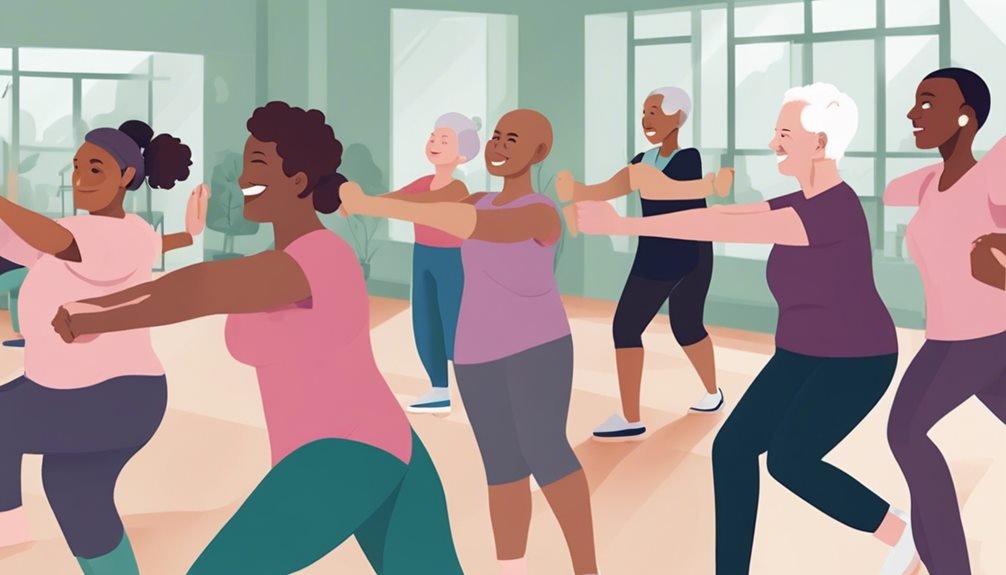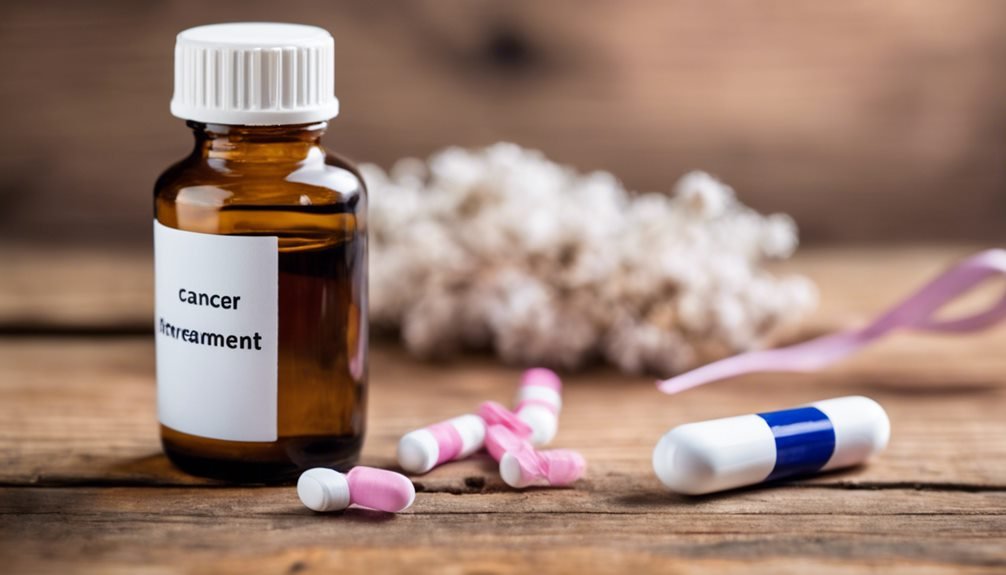Did you know that regular exercise has been shown to decrease the risk of cancer progression by up to 50%? The impact of physical activity on cancer treatment outcomes is significant, yet often overlooked. By exploring the multifaceted benefits of exercise for cancer patients, you can uncover a holistic approach to complement traditional treatment methods. From enhancing immune function to reducing treatment-related side effects, the role of exercise in cancer care is a compelling area that deserves further exploration.
Key Takeaways
- Exercise improves treatment efficacy and reduces side effects.
- Physical activity boosts immune function for fighting cancer cells.
- Regular exercise enhances quality of life and mood.
- Building strength and endurance aids in faster recovery times.
- Adherence to tailored exercise guidelines is essential for optimal benefits.
Benefits of Exercise for Cancer Patients
Numerous studies have shown that incorporating regular exercise into the treatment regimen of cancer patients can have significant benefits. One crucial aspect is the survivorship benefits that exercise offers. Physical activity has been linked to improved overall survival rates, decreased risk of cancer recurrence, and enhanced quality of life for cancer survivors. By engaging in regular exercise, individuals can reduce fatigue, alleviate symptoms of depression and anxiety, and enhance their physical function and well-being.
Another essential factor to consider is exercise adherence. Encouraging cancer patients to maintain a consistent exercise routine can be challenging but is vital for maximizing the benefits. Healthcare providers play a crucial role in supporting patients in adhering to their exercise plans, providing guidance, motivation, and monitoring progress.
Setting achievable goals, creating personalized exercise plans, and offering ongoing support are key strategies to promote exercise adherence among cancer patients.
Impact on Treatment Outcomes
Research consistently demonstrates the positive impact of regular exercise on treatment outcomes for cancer patients. Engaging in physical activity can significantly improve treatment efficacy and overall well-being during cancer therapy. By focusing on exercise adherence, individuals can optimize their treatment outcomes.
Here are five key ways in which exercise impacts treatment outcomes:
- Enhanced Treatment Efficacy: Regular exercise has been linked to improved treatment response and effectiveness.
- Reduced Side Effects: Physical activity can help alleviate common treatment side effects such as fatigue, nausea, and neuropathy.
- Improved Quality of Life: Exercise contributes to a better quality of life by enhancing mood, reducing stress, and promoting overall well-being.
- Enhanced Immune Function: Physical activity boosts immune function, potentially aiding in the body's ability to fight cancer cells.
- Faster Recovery: Patients who exercise regularly often experience quicker recovery times after surgeries or treatments.
Reducing Cancer Recurrence Risk

Exercise plays a crucial role in reducing the risk of cancer recurrence. Engaging in physical activity not only improves overall health but also specifically benefits cancer survivors by reducing the chances of cancer returning. Survivorship strategies emphasize the importance of incorporating regular exercise into daily routines as a preventive measure against cancer recurrence. Following exercise guidelines tailored to individual needs and capabilities is essential in maximizing the protective effects of physical activity.
To provide a clearer picture, below is a table outlining general exercise guidelines for cancer survivors:
| Exercise Type | Frequency | Duration |
|---|---|---|
| Aerobic | 3-5 times per week | 30-60 minutes per session |
| Strength Training | 2-3 times per week | 20-30 minutes per session |
| Flexibility Exercises | Daily | 10-15 minutes per session |
Improving Quality of Life
To enhance the quality of life for cancer survivors, focusing on holistic well-being beyond physical health is essential. Engaging in survivorship support programs and prioritizing exercise adherence can significantly contribute to improving overall well-being. Here are five key ways to enhance the quality of life for cancer survivors:
- Participation in Support Groups: Joining survivorship support groups can provide emotional support, reduce feelings of isolation, and promote a sense of community.
- Mind-Body Practices: Incorporating activities like yoga, meditation, or tai chi can help reduce stress, anxiety, and improve mental well-being.
- Nutritional Counseling: Seeking guidance from a nutritionist can ensure a balanced diet that supports overall health and energy levels.
- Social Connections: Maintaining relationships with loved ones, friends, and support networks can enhance emotional well-being and reduce feelings of loneliness.
- Personalized Exercise Plans: Working with a healthcare provider to create a tailored exercise routine can improve physical strength, reduce fatigue, and enhance overall quality of life.
Physical Benefits of Exercise

Engaging in regular physical activity holds numerous benefits for cancer survivors beyond just improving strength and stamina. Strength training, such as lifting weights or using resistance bands, can help rebuild muscle mass and increase overall strength, which may have been lost during cancer treatment.
Endurance exercises like walking, swimming, or cycling can enhance cardiovascular health and improve endurance levels, allowing survivors to better cope with the challenges of daily life.
Additionally, physical activity can aid in managing side effects of cancer treatment, such as fatigue, by boosting energy levels and reducing feelings of tiredness. It can also help in maintaining a healthy body weight, which is crucial for overall well-being and reducing the risk of cancer recurrence.
Mental Health Benefits
When faced with the challenges of cancer treatment, it's crucial to recognize the significant impact that physical activity can have on mental health. Engaging in exercise not only benefits your physical well-being but also plays a vital role in supporting your emotional well-being during this difficult time. Here are some ways in which exercise can contribute to your mental health:
- Boosts Mood: Physical activity stimulates the release of endorphins, which are natural mood lifters.
- Reduces Anxiety: Regular exercise has been shown to decrease feelings of anxiety and improve overall mental well-being.
- Enhances Self-Esteem: Achieving fitness goals through exercise can boost your confidence and self-esteem.
- Promotes Relaxation: Engaging in physical activity can act as a form of meditation, helping to reduce stress and promote relaxation.
- Provides Distraction: Exercise serves as a positive distraction from the challenges of cancer treatment, allowing you to focus on something empowering and beneficial for your health.
Integrating Exercise Into Treatment Plans

Integrating exercise into cancer treatment plans is a pivotal component that can significantly enhance overall well-being and quality of life for patients. Exercise recommendations tailored to individual needs and capabilities play a crucial role in the holistic approach to cancer care. Research indicates that incorporating physical activity into treatment regimens can reduce the side effects of cancer treatments, improve physical function, alleviate fatigue, and boost emotional well-being.
When integrating exercise into cancer treatment plans, healthcare providers should consider the specific type and stage of cancer, as well as the patient's overall health and fitness level. Treatment integration involves developing personalized exercise programs that may include a combination of aerobic, strength training, and flexibility exercises. These tailored exercise recommendations can help patients manage treatment-related symptoms, enhance recovery, and improve their overall quality of life.
Types of Recommended Activities
Amidst cancer treatment, the selection of appropriate physical activities plays a vital role in optimizing health outcomes and enhancing quality of life. When considering types of recommended activities, it's important to focus on activities that not only promote physical well-being but also provide emotional support and community engagement. Here are some beneficial options:
- Group Exercise: Participating in group exercise classes such as yoga, Pilates, or aerobics can provide a sense of camaraderie and support from others facing similar challenges.
- Outdoor Activities: Engaging in outdoor activities like walking, hiking, or gardening can offer a refreshing change of scenery and exposure to natural light, which can positively impact mood and overall well-being.
Safety Considerations for Patients

As you explore physical activities during cancer treatment, ensuring the safety of patients is paramount. When engaging in exercise, focus on preventing injuries by starting slowly and gradually increasing intensity. Building strength is essential but should be done under the guidance of healthcare professionals or certified trainers familiar with cancer patients' needs.
Monitor progress by keeping track of your workouts and any symptoms experienced. It's crucial to listen to your body and avoid pushing yourself too hard to prevent fatigue. Adequate rest periods and hydration are key components in staying safe during physical activity. If you experience any unusual symptoms or pain, stop exercising and consult your healthcare team immediately.
Always warm up before exercising and cool down afterward to help prevent muscle strain or injury. By following these safety considerations, you can incorporate exercise into your cancer treatment plan effectively and safely.
Overcoming Exercise Barriers
Facing obstacles when it comes to incorporating exercise into your cancer treatment plan is common, but with the right approach, these barriers can be overcome. It's important to acknowledge the challenges you may encounter and find ways to navigate through them.
Here are some strategies to help you overcome exercise barriers:
- Set Realistic Goals: Start with small, achievable goals and gradually increase the intensity as you progress.
- Find a Support System: Surround yourself with encouraging friends, family, or support groups to keep you motivated.
- Listen to Your Body: Pay attention to how your body responds to exercise and adjust your routine accordingly.
- Incorporate Variety: Keep your workouts interesting by trying different activities to prevent boredom and plateaus.
- Celebrate Your Achievements: Acknowledge your milestones, no matter how small, to stay motivated and focused on your progress.
Support Systems for Patients

Navigating a cancer diagnosis can be challenging, especially when it comes to managing the physical and emotional aspects of treatment. Peer support plays a crucial role in helping patients cope with the rollercoaster of emotions that often accompany a cancer diagnosis. Connecting with others who are going through similar experiences can provide a sense of understanding, empathy, and hope. Support groups, online forums, or one-on-one peer mentoring can offer a safe space for sharing feelings and tips for dealing with the challenges of treatment.
Additionally, family involvement is key in creating a strong support system for cancer patients. Loved ones can offer practical assistance, emotional support, and companionship during treatment.
Involving family members in discussions with healthcare providers can also help ensure that everyone is on the same page regarding treatment plans and goals. By leaning on peer support networks and involving family in the journey, cancer patients can feel supported, empowered, and better equipped to face the challenges ahead.
Long-Term Impact of Exercise
Support systems like peer groups and family involvement are vital for cancer patients, offering a network of understanding and care during the treatment journey. When it comes to the long-term impact of exercise for cancer survivors, maintaining survivorship support and exercise adherence becomes crucial. Here are key points to consider:
- Improved Quality of Life: Regular exercise post-treatment can enhance physical functioning and reduce fatigue, leading to an overall improved quality of life.
- Reduced Risk of Recurrence: Studies suggest that consistent physical activity may lower the risk of cancer recurrence and improve survival rates.
- Mental Health Benefits: Engaging in exercise can help alleviate symptoms of anxiety, depression, and stress commonly experienced by cancer survivors.
- Physical Strength and Resilience: Building strength through exercise can enhance resilience, making it easier to cope with the physical and emotional challenges of survivorship.
- Community Engagement: Participating in group exercise programs fosters a sense of community and support among survivors, encouraging exercise adherence and overall well-being.
Frequently Asked Questions
Can Exercise Help With Managing Cancer-Related Fatigue?
Exercise can indeed help with managing cancer-related fatigue by improving your energy levels and overall well-being. When considering exercise intensity, it's important to start with low to moderate levels and gradually increase based on your tolerance. Timing considerations suggest that even short bouts of exercise throughout the day can be beneficial. Consult with your healthcare team to create a personalized exercise plan that suits your individual needs and health status.
Are There Specific Exercises to Avoid During Cancer Treatment?
During cancer treatment, it's crucial to consider exercise intensity and duration. Avoid high-impact activities like running or heavy weightlifting that may strain your body. Opt for low-impact exercises such as walking, swimming, or gentle yoga.
Focus on shorter sessions of around 20-30 minutes to prevent overexertion. Always consult your healthcare provider or a qualified fitness professional to create a safe and effective exercise plan tailored to your specific needs.
How Soon After Surgery Can I Start Exercising?
As you emerge from the stillness of surgery, embrace movement like petals unfurling at dawn. Remember, post-surgery precautions are crucial. Listen to your body's whispers and seek guidance from your healthcare team. Early movement can aid in circulation, reduce stiffness, and enhance overall well-being. Start gently, focusing on light activities such as walking. Be patient with yourself and allow healing to bloom in its own time.
Can Exercise Reduce the Side Effects of Chemotherapy?
You can definitely reduce chemotherapy side effects with exercise. The intensity and frequency matter. Moderate-intensity exercise like walking or swimming a few times a week can help. It can reduce fatigue, improve mood, and boost overall well-being.
Always consult your healthcare provider before beginning any exercise program during cancer treatment to ensure it's safe and suitable for your specific situation. Listening to your body and staying consistent with your routine is key.
What Role Does Nutrition Play in Conjunction With Exercise for Cancer Patients?
When it comes to cancer patients' diet, nutrition and exercise combination is key. Imagine a well-oiled machine, with nutrition providing the fuel and exercise keeping everything running smoothly.
For cancer patients, a balanced diet rich in nutrients can enhance the benefits of physical activity, aiding in recovery and overall well-being. By fueling your body with the right foods and staying active, you can support your immune system and improve your quality of life.
Conclusion
In conclusion, incorporating regular exercise into your cancer treatment journey can have a profound impact on your overall well-being. By improving treatment outcomes, reducing recurrence risks, and enhancing quality of life, exercise has the power to transform your experience. Remember, with the right guidance and support, you can conquer any barriers standing in your way. So lace up those sneakers, hit the gym, and take charge of your health with the power of exercise – it's truly a game-changer!





